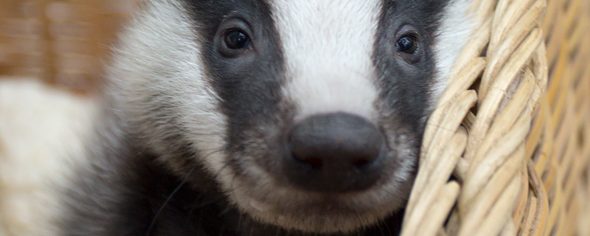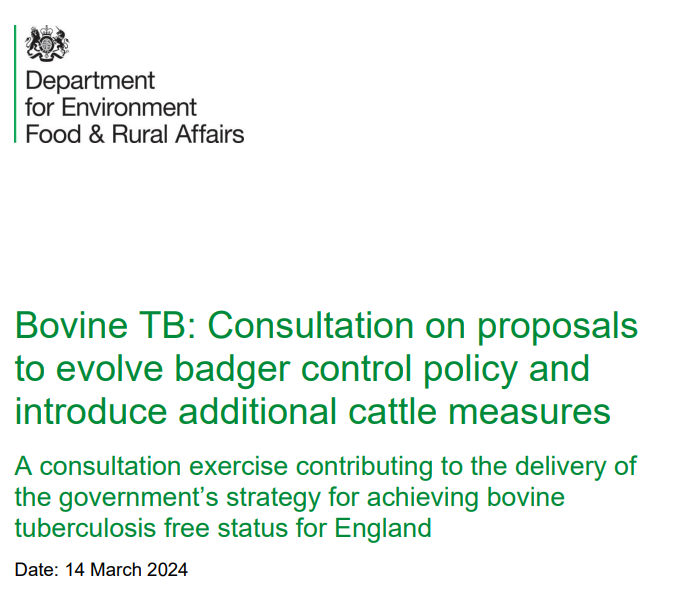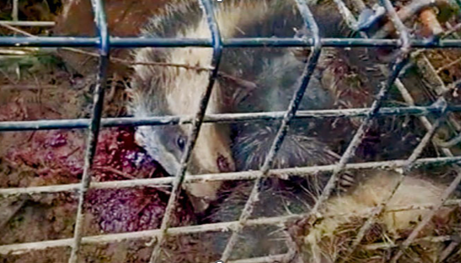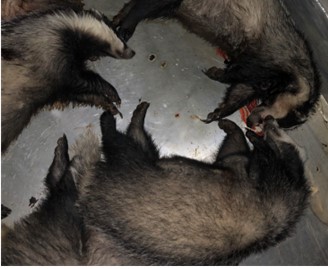The TB status of cattle herds – how does that work?
The Animal and Plant Health Agency (APHA) maintain in recent publications (Birch et al. 2024 and APHA epidemiology reports for 2023) that it is the number of ‘OTF-W’ herd breakdowns that is the best headline measure of the change in bovine TB herd incidence in relation to transmission caused by badgers. How credible is this claim and why do they make it? The reality is that OTF-W (Officially TB Withdrawn) and OTF-S (Officially TB Suspended) cattle herds are simply two categories of a positive disease status.

The SICCT test – and the difference between ‘reactors’ and ‘inconclusive reactors’
The most commonly used test for bovine TB in cattle currently is the tuberculin test or SICCT (Single Intradermal Comparative Cervical Tuberculin) test. It is the main test for which farmers receive financial compensation if they receive a ‘positive result’ or ‘reactor’, and cattle are slaughtered prematurely. One big limitation of the tuberculin skin test is its sensitivity. Studies suggest that skin test herd sensitivity in Great Britain averages around 80% at ‘standard interpretation’. In practical terms, this means that on average 20% of TB-infected cattle herds may be missed by one round of skin testing, at ‘standard interpretation’, and it might be more. Even at ‘severe interpretation’ (explained later), many individuals slip through the testing net.
The skin test involves the injection of two different deactivated TB proteins, bovine and avian, in the neck area of each individual animal in a herd, followed 3 days later by a check of the injection sites to measure the extent of any skin thickening reaction (lump).
The SICCT test for bovine tuberculosis (bTB) is read by comparing the size of the skin reaction to bovine tuberculin and avian tuberculin. At ‘standard interpretation’, the test is ‘positive’ when the reaction to bovine tuberculin is greater than the reaction to avian tuberculin by 4 mm or more. Where the reaction to bovine tuberculin is greater than the reaction to avian tuberculin, but by less than 4mm, the result has been considered ‘inconclusive’ (IR) and usually retested after 60 days. Where the reaction to bovine tuberculin is the same as the reaction to avian tuberculin, the test is ‘negative‘.
If the IR subsequently tests clear, it can rejoin the herd. These animals, then known as ‘resolved IRs’, are either isolated, restricted for life to the holding in which they were found, or sent for slaughter according to rules on the risk level at each location. If the second test shows a reaction (tuberculin lump is 4 mm or more than the avian tuberculin lump), individuals are classed as a ‘reactor’ and compulsorily slaughtered. Sometimes herds have to pass two tests 60 days apart after an initial ‘inconclusive‘ test to regain ‘TB Free’ status. Animals with lumps less than 4mm may also be slaughtered as ‘direct contacts’ (DC’s), (individuals that have been in contact with known infected animals).
Research has found that the odds of a ‘resolved IR’ becoming a subsequent ‘reactor’ during study periods were seven and nine times greater than for negative testing cattle in the HRA and Edge Area of England respectively (see May et al. 2019 here). So why create such an important operational, yet subjective division between ‘reactors’ and ‘inconclusives’?
What happens to an animal that is a ‘reactor’?
 An animal that is a ‘reactor’ is slaughtered and examined for signs of bTB. It must have either a ‘post-mortem examination’ (PME) undertaken either by an APHA veterinary pathologist, or in the vast majority of cases, an examination at an abattoir where meat inspectors undertake a ‘simple post-mortem meat inspection’ (PMMI). Both processes (PME & PMMI) are looking for ‘visible lesions’. These are physiological changes to organs, glands and other areas caused by the disease. Tissue samples from selected ‘positive’ animals are taken for further testing (bacteriological culture) in one of APHA’s designated diagnostic laboratories to try and grow M. bovis (the bovine TB bacilli) and then identify the specific strain of the bacterium through DNA typing or sequencing. Alternatively, M. bovis may be confirmed via PCR (Polymerase Chain Reaction) analysis. PCR is a laboratory technique for rapidly producing copies of a specific segment of DNA, which can then be studied in greater detail. Evidence of bTB infection by one of these methods results in the ‘confirmed’ status.
An animal that is a ‘reactor’ is slaughtered and examined for signs of bTB. It must have either a ‘post-mortem examination’ (PME) undertaken either by an APHA veterinary pathologist, or in the vast majority of cases, an examination at an abattoir where meat inspectors undertake a ‘simple post-mortem meat inspection’ (PMMI). Both processes (PME & PMMI) are looking for ‘visible lesions’. These are physiological changes to organs, glands and other areas caused by the disease. Tissue samples from selected ‘positive’ animals are taken for further testing (bacteriological culture) in one of APHA’s designated diagnostic laboratories to try and grow M. bovis (the bovine TB bacilli) and then identify the specific strain of the bacterium through DNA typing or sequencing. Alternatively, M. bovis may be confirmed via PCR (Polymerase Chain Reaction) analysis. PCR is a laboratory technique for rapidly producing copies of a specific segment of DNA, which can then be studied in greater detail. Evidence of bTB infection by one of these methods results in the ‘confirmed’ status.
It is not always possible to locate ‘visible lesions’ at PMMI, and therefore culture the bacterium from infected animals. This is particularly so if ‘micro-lesions’ are present; these are too small to be detected visually and can only be identified by fine sectioning of tissues. Furthermore, although ‘visible lesions’ of bTB are usually located in the lung tissues and associated lymph nodes, their location can vary depending on the movement of infection around the animal post-primary infection. The size and number of visible lesions (if present) can also vary and are not always correlated with the length of time an animal might have been infected.
How accurate are the abattoir checks for TB lesions – and thus how accurate is the ‘confirmed’ status?
Stating the obvious, abattoir checks are very different to laboratory checks: the proportion of abattoir checks to laboratory checks is unclear. The ‘necropsy’ (autopsy for animals) of the dead animal in an abattoir is a rapid procedure, undertaken in slaughterhouse conditions. The meat inspector doing the procedure has a limited amount of time to look for TB lesions; some have reported as little as 4 minutes per animal. In this time, they have to administer 6 major cuts to the carcass and may take samples in 3 different locations; glands, lungs, gut.
During the conveyor belt nature of rendering, it is quite possible that the animal to whom each set of guts belong is unclear, so in the event of lesions being found, the process has to be stopped, causing delay and cost to try to clarify. In order to avoid faecal contamination of the abattoir, the guts are rarely (if ever) opened. The search for gut lesions is therefore restricted to examination of the outside of the organ only, and is it therefore more likely to miss diseased tissue here than in other locations.
If lesions are found, restrictions start to kick in. The abattoirs must temporarily slow operations and the area must be cleaned, losing working time & efficiency. Extra paperwork must be completed. It is not in the interest of any of those involved to find lesions – the schedule becomes less efficient and less profitable. It has even been suggested that ‘not spotting’ disease can sometimes be encouraged.
How do ‘confirmed reactors’ and ‘unconfirmed reactors’ relate to OTF-S and OTF-W status?
If the animal is registered as a ‘confirmed reactor’, the herd from which it came is registered as ‘OTF-W’ (withdrawn). If no lesions are found, and the checks for M. bovis bacteria are negative, the animal is registered as an ‘unconfirmed reactor’ and the herd is registered or remains as ‘OTF-S’ (suspended). A herd is also considered ‘OTF-S’ when animals are removed/separated due to a skin test finding of ‘inconclusive reactors’ and must be retested to become OTF (Officially TB Free) again.
Is there a clear difference between ‘OTF-W’ and ‘OTF-S’ using the ‘confirmed’ and ‘unconfirmed’ method of disease surveillance?
The division of ‘reactors’ into ‘confirmed’ and ‘unconfirmed’ has created an artificial and unmeasurable division of disease diagnosis and infectiousness. All ‘reactors’ have been exposed to bTB, all have some level of disease, all may be infectious. All should be treated as such. Which is why in Wales, since 01 April 2023, the SICCT test is read at ‘severe interpretation’. This means that the ‘positive’ cut-off point (difference in bump size) is lowered so that some animals previously classified as ‘inconclusive reactors’ (IRs) at the standard interpretation are now classified as full ‘reactors’. Thus Wales now regards the majority of herds with ‘reactors’ of all kinds as ‘OTF-W’ by default.
The reason bovine TB proliferates is because the OTF-S herds that clear their onward tests, but that are in reality still infected, are likely to go on to infect the herds to which they are sold, and the disease can then take years to appear in that new herd. ‘Reactors’ from the new herd may not reveal ‘visible lesions’ at PME, and then the source of disease cannot be traced back. In this situation, ‘environmental’ sources (usually badgers) have often been blamed for the ‘new’ infection.
The current system is based on the outmoded vet and farmer ‘rule of thumb’ that cattle may carry bovine TB in a manner that is low risk to other cows. This is not the case, as any that are truly in remission are always vulnerable to ‘recrudescence’ and becoming infectious, and it is an unpredictable risk. It could happen for a range of reasons such as stress, ill health or use of medication. The kind of long term ‘latency’ seen in human TB has never been demonstrated in cattle.
The result of the current testing regime is to separate positive testing animals into two clearly overlapping categories. The high specificity of the SICCT test (approximately 99.98% at standard interpretation) means that any cow that tests positive is almost certain to carry bovine TB.
So why has APHA chosen to use OTF-W as a measure of disease rather than OTF-S?
The number of OTF-W herds has been coming down in recent years as the later cases / older infections are those that are most likely to be detected by testing. DEFRA are keen to report that their bTB control policy is working, and they largely use data for OTF-W rather than OTF-S which has stayed constant or is slightly rising, to try to show this (see below & recent letter in Vet Record). This is even though common sense says that ‘all reactors’ (both conclusive and inconclusive) are positive for bovine TB, and therefore better reflect ‘new infection’ rate. So OTF-W + OTF-S would be the statistic that best shows overall disease trends. The current (September 2024) bTB Dashboard for England show the total number of New Herd Incidents (NHI’s) at 2464, of which 1042 (42%) are OTF-W, and the higher 1422 (58%) are OTF-S.

And also…
The results of the Randomised Badger Culling Trial (RBCT) are the basis for the government badger cull policy. The RBCT is the science that DEFRA has used to create policy, and in court to defend their decisions to experiment with badger culling from 2013. The RBCT claimed that proactive badger culling can significantly reduce bovine TB in cattle within cull areas; very many subsequent studies are heavily derived from it. The RBCT claimed a 19% benefit from badger culling from analyses that used only OTF-W data. However, when OTF-S + OTF-W data were used, all analyses agreed that there was no measured benefit from badger culling. Badger culling did not have any effect at all.
It is not difficult to see where the oversights have been and are still being made. How is it possible that basic scientific and veterinary evidence is being so badly misrepresented? It is clear that the distraction caused by the claim that badger culling will deliver significant disease benefit has been disastrous. Published science shows that it hasn’t worked (here) and that it was never going to work (here and here). So why don’t DEFRA urgently do something about it?


 In February, DEFRA’s Animal and Plant Agency (APHA) published a controversial paper (Birch et al.) in Scientific Reports that the DEFRA Minister Steve Barclay trumpeted immediately as showing that badger culling since 2013 was ‘working’ (
In February, DEFRA’s Animal and Plant Agency (APHA) published a controversial paper (Birch et al.) in Scientific Reports that the DEFRA Minister Steve Barclay trumpeted immediately as showing that badger culling since 2013 was ‘working’ ( DEFRA’s tactics appeared to be to try to justify badger culling in order to reverse the ‘phasing out’ of badger culling by the 2020 ‘Next Steps’ policy. This was perhaps also addressing the High Court’s expectation, stated 5 years previously, that policy should ‘adapt and learn’ from the results of Supplementary Badger Culling. The DEFRA plan, as revealed on 14th March, was to introduce something called ‘targeted culling‘ (
DEFRA’s tactics appeared to be to try to justify badger culling in order to reverse the ‘phasing out’ of badger culling by the 2020 ‘Next Steps’ policy. This was perhaps also addressing the High Court’s expectation, stated 5 years previously, that policy should ‘adapt and learn’ from the results of Supplementary Badger Culling. The DEFRA plan, as revealed on 14th March, was to introduce something called ‘targeted culling‘ ( The March 2024 DEFRA plan was to allow extensive culling into the future across England at the discretion of the Chief Veterinary Officer, potentially under a general licence, further negating provisions of the Protection of Badgers Act 1992. It looked like Defra were trying to put a policy in place before a General Election, to commence in autumn 2024. The DEFRA plan looked like a normalization of widespread badger culling into the future. Likely to further stimulate illegal badger culling that is now reported to be rife in some bovine TB areas.
The March 2024 DEFRA plan was to allow extensive culling into the future across England at the discretion of the Chief Veterinary Officer, potentially under a general licence, further negating provisions of the Protection of Badgers Act 1992. It looked like Defra were trying to put a policy in place before a General Election, to commence in autumn 2024. The DEFRA plan looked like a normalization of widespread badger culling into the future. Likely to further stimulate illegal badger culling that is now reported to be rife in some bovine TB areas.
 Ultimately, the consultation fell victim to the announcement by Prime Minister Rishi Sunak on 22nd May of a General Election on 4th July. This froze consideration of the consultation responses until after the election. The Labour Party manifesto for the 2024 General Election was published on 13th June, and stated its intention to end “ineffective” badger culling, as previously pledged during the 2019 general election. Labour had been keeping very quiet about its position on culling in the months leading up to the election. Presumably this was a tactic to placate the farming vote which was needed before Reform UK Party decided to stand. It appeared to have agreed to keep some badger culling going as a part of a back-room deal with the NFU, a fix that was later exposed by reliable sources (
Ultimately, the consultation fell victim to the announcement by Prime Minister Rishi Sunak on 22nd May of a General Election on 4th July. This froze consideration of the consultation responses until after the election. The Labour Party manifesto for the 2024 General Election was published on 13th June, and stated its intention to end “ineffective” badger culling, as previously pledged during the 2019 general election. Labour had been keeping very quiet about its position on culling in the months leading up to the election. Presumably this was a tactic to placate the farming vote which was needed before Reform UK Party decided to stand. It appeared to have agreed to keep some badger culling going as a part of a back-room deal with the NFU, a fix that was later exposed by reliable sources ( An important new extensive re-evaluation of the Randomised Badger Culling Trial was published in Nature Scientific Reports by Prof Paul Torgerson with others, on 15th July, shaking the foundation stone of Government policy since 2011. It provided further and highly extensive evidence that the role of badgers in bovine TB in cattle was fatally misconstrued, and the problems had not been spotted over 20 years ago (
An important new extensive re-evaluation of the Randomised Badger Culling Trial was published in Nature Scientific Reports by Prof Paul Torgerson with others, on 15th July, shaking the foundation stone of Government policy since 2011. It provided further and highly extensive evidence that the role of badgers in bovine TB in cattle was fatally misconstrued, and the problems had not been spotted over 20 years ago ( Throughout 2023 and 2024 the Oxfordshire Badger Group (OBG), with support from others, had tried to initiate discussion of the RBCT design and findings with Oxford University, but reported a wall of reluctance or silence. Around 7,000 badgers have been shot in Oxfordshire so far. On 18th July OBG presented a petition with over 50,000 signatures to Oxford University School of Biology in central Oxford. OBG called on Oxford University to own what it called “Your Bloody Science” and asked them to “Speak out against badger extermination”, (
Throughout 2023 and 2024 the Oxfordshire Badger Group (OBG), with support from others, had tried to initiate discussion of the RBCT design and findings with Oxford University, but reported a wall of reluctance or silence. Around 7,000 badgers have been shot in Oxfordshire so far. On 18th July OBG presented a petition with over 50,000 signatures to Oxford University School of Biology in central Oxford. OBG called on Oxford University to own what it called “Your Bloody Science” and asked them to “Speak out against badger extermination”, (
 There followed a tirade of rather ill-founded and rushed accusations and complaints by multiple members of the usually secretive BTB Partnership (
There followed a tirade of rather ill-founded and rushed accusations and complaints by multiple members of the usually secretive BTB Partnership (

 On 24th October APHA’s “Year End Descriptive Epidemiology Reports” for Bovine TB control were published online for the Edge Area counties of Berkshire, Buckinghamshire, Cheshire, Derbyshire, East Sussex, Hampshire, Leicestershire, Northamptonshire, Nottinghamshire, Oxfordshire and Warwickshire. Progress is no longer on target for any of these areas, apparently due to inadequate funding for disease control following Brexit cutbacks (see
On 24th October APHA’s “Year End Descriptive Epidemiology Reports” for Bovine TB control were published online for the Edge Area counties of Berkshire, Buckinghamshire, Cheshire, Derbyshire, East Sussex, Hampshire, Leicestershire, Northamptonshire, Nottinghamshire, Oxfordshire and Warwickshire. Progress is no longer on target for any of these areas, apparently due to inadequate funding for disease control following Brexit cutbacks (see 
 As the year wound down, the Oxfordshire Badger Group supported a scientific seminar, in Oxford, delivered by Prof. Paul Torgerson on 18th November: key RBCT academics together with Defra & APHA officials were invited to discuss the science and statistics but all declined.
As the year wound down, the Oxfordshire Badger Group supported a scientific seminar, in Oxford, delivered by Prof. Paul Torgerson on 18th November: key RBCT academics together with Defra & APHA officials were invited to discuss the science and statistics but all declined.  On 3rd December, Rob Pownall of Protect The Wild launched a parliamentary petition to end the English badger cull. Standing at around 30,000 signatures at the time of writing, the petition calls for “an immediate end to the cull and the implementation of cattle focused measures to control bTB, rather than what we see as scapegoating wildlife.” As the petition points out, research that has been “peer reviewed and published, shows no evidence that culling badgers reduces confirmed bTB in cattle. Over 230,000 badgers — many healthy — have been killed, disrupting ecosystems without solid scientific justification”. Please add your name to this petition
On 3rd December, Rob Pownall of Protect The Wild launched a parliamentary petition to end the English badger cull. Standing at around 30,000 signatures at the time of writing, the petition calls for “an immediate end to the cull and the implementation of cattle focused measures to control bTB, rather than what we see as scapegoating wildlife.” As the petition points out, research that has been “peer reviewed and published, shows no evidence that culling badgers reduces confirmed bTB in cattle. Over 230,000 badgers — many healthy — have been killed, disrupting ecosystems without solid scientific justification”. Please add your name to this petition  Vetsuisse Faculty at Zurich University. This looked at the flawed assumptions made back in the 1970’s that led to badgers being wrongly labelled as a ‘self-perpetuating bTB reservoir‘, on to field trials that tried to show a ‘bTB perturbation effect’, and statistics chosen to ‘prove‘ this as a way to stop culling. And the u
Vetsuisse Faculty at Zurich University. This looked at the flawed assumptions made back in the 1970’s that led to badgers being wrongly labelled as a ‘self-perpetuating bTB reservoir‘, on to field trials that tried to show a ‘bTB perturbation effect’, and statistics chosen to ‘prove‘ this as a way to stop culling. And the u







 The ‘Comment’ submission to the Royal Society Open Science is an extensive response to the two new Mills et al. (2024) papers which reproduced much of Torgerson et al.’s models, whilst re-interpreting the results.
The ‘Comment’ submission to the Royal Society Open Science is an extensive response to the two new Mills et al. (2024) papers which reproduced much of Torgerson et al.’s models, whilst re-interpreting the results. Hotspot 29
Hotspot 29





